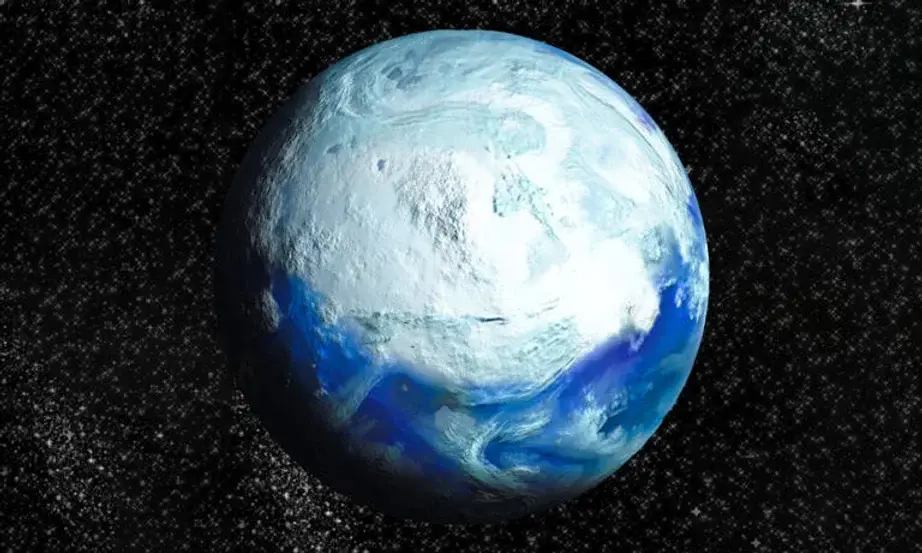The chilling cause of Earth’s extreme ice-age 700 million years ago
Geologists in Australia have uncovered a chilling discovery about Earth’s ancient past, shedding light on a mystery that puzzled scientists.

Geologists in Australia have uncovered a chilling discovery about Earth’s ancient past, shedding light on a mystery that puzzled scientists for years. (CREDIT: CC BY-SA 3.0)
Geologists in Australia have uncovered a chilling discovery about Earth's ancient past, shedding light on a mystery that puzzled scientists for years. Their research, recently published in the journal Geology, delves into the extreme ice-age climate that gripped the planet over 700 million years ago.
Lead author of the study, Dr. Adriana Dutkiewicz, an ARC Future Fellow, paints a vivid picture of this icy epoch, stating, "Imagine the Earth almost completely frozen over. That's just what happened about 700 million years ago; the planet was blanketed in ice from poles to equator and temperatures plunged. However, just what caused this has been an open question."
The investigation was sparked by the remarkable glacial remnants found in the Flinders Ranges of South Australia, a testament to Earth's ancient climatic upheavals. Co-author Professor Alan Collins from the University of Adelaide led a geological field trip to the region, inspiring the team to unravel the mysteries of this prolonged ice age.
Known as the Sturtian glaciation, this icy period endured from 717 to 660 million years ago, predating the existence of dinosaurs and complex land plants. Dr. Dutkiewicz remarks, "Various causes have been proposed for the trigger and the end of this extreme ice age, but the most mysterious aspect is why it lasted for 57 million years—a time span hard for us humans to imagine."
To decipher the puzzle, the team turned to sophisticated plate tectonic models and computer simulations. They linked the breakup of the ancient supercontinent Rodina to volcanic CO2 emissions along mid-ocean ridges, where new ocean crust forms.
Their analysis revealed a crucial correlation: the onset of the Sturtian ice age coincided with a historic low in volcanic CO2 emissions. Moreover, this reduced CO2 outflux persisted throughout the entirety of the ice age.
Professor Dietmar Müller from the University of Sydney emphasizes the geological dominance over climate during this era, stating, "Geology ruled climate at this time." The team's findings suggest a dual mechanism driving the ice age: a decline in volcanic CO2 emissions due to tectonic reorganization, coupled with extensive erosion of continental volcanic rocks in Canada, which consumed atmospheric CO2.
Related Stories
This double whammy led to a drastic drop in atmospheric CO2 levels, triggering glaciation when concentrations fell below 200 parts per million—less than half of today's levels.
The implications of this research extend beyond Earth's ancient history. It prompts speculation about the planet's future trajectory, particularly in light of theories proposing the eventual formation of a supercontinent dubbed Pangea Ultima.
According to Dr. Dutkiewicz, "The Earth is currently on a trajectory of lower volcanic CO2 emissions, as continental collisions increase and the plates slow down." This raises the intriguing possibility that Pangea Ultima might veer towards another ice age scenario.
However, Dr. Dutkiewicz is quick to caution against drawing direct parallels to the present. She emphasizes the glacial pace of geological climate change compared to the rapidity of human-induced climate change, as highlighted by NASA.
As we contemplate Earth's future, it underscores the complex interplay between tectonics, volcanic activity, and atmospheric carbon levels—an intricate dance that has shaped our planet's climate over millions of years.
More interesting facts about the Sturtian Ice Age
The Sturtian Ice Age, which occurred approximately 717 to 660 million years ago during the Cryogenian Period, is one of the most extreme ice ages in Earth's history. Here are some interesting facts about it:
Snowball Earth Hypothesis: The Sturtian Ice Age is often associated with the "Snowball Earth" hypothesis. This suggests that the entire planet, from pole to equator, may have been covered in ice, leading to a frozen, white world for millions of years.
Longest Ice Age: The Sturtian glaciation is considered one of the longest glacial periods in Earth's history, lasting around 57 million years. It represents a time when glaciers and ice sheets likely extended across most of the planet's surface.
Volcanic Triggers: There is evidence that massive volcanic eruptions, possibly associated with the formation of the supercontinent Rodinia, released vast amounts of CO₂, initially increasing atmospheric temperatures. However, the breakdown of rock, which absorbs CO₂, eventually led to rapid cooling and widespread glaciation.
Life Under Ice: Despite extreme conditions, some forms of microbial life managed to survive. Hydrothermal vents and pockets of liquid water under the ice may have provided refuge for extremophiles, allowing certain forms of life to endure this harsh period.
Post-Ice Age Evolution Boom: After the Sturtian Ice Age ended, Earth experienced a warming phase that allowed multicellular life to flourish. This period of extreme cold is thought to have been a critical evolutionary bottleneck that paved the way for a burst of biological diversification afterward, including the emergence of complex organisms.
Cap Carbonates: After the Sturtian Ice Age, unique rock formations known as "cap carbonates" were deposited. These carbonate rocks were formed as CO₂ levels soared and the ice sheets melted, causing rapid changes in the climate. Cap carbonates are considered one of the key pieces of evidence for the Snowball Earth hypothesis.
Geological Evidence: Glacial deposits from the Sturtian Ice Age have been found on nearly every continent, indicating the vast reach of the glaciers. These glacial deposits provide crucial information about the ancient climate and are key markers for understanding Earth's deep history.
Influence on the Atmosphere: The extreme conditions of the Sturtian Ice Age significantly influenced Earth's atmosphere. The glaciation may have helped to reduce greenhouse gases, setting a precedent for future climate regulation mechanisms, and demonstrating how feedback loops can lead to dramatic planetary climate shifts.
The Sturtian Ice Age provides insight into Earth's ability to undergo extreme climate variations and recover, playing a significant role in shaping the evolution of life on our planet.
Note: Materials provided above by The Brighter Side of News. Content may be edited for style and length.
Like these kind of feel good stories? Get The Brighter Side of News' newsletter.



